all observers see the same thing.
The density of the Universe decreases as the Universe expands.
We define a scale factor, R, which can be thought of as the distance between any two clusters of galaxies. This scale factor is getting larger with time (the Universe is expanding).
Run the expansion backward in time. Density and Temperature increase as R decreases. When R = 0, density = infinity, temperature = infinity (a singularity!!!).
We call this the Hot Big Bang. Which is a misnomer. It was actually a name given the theory by astronomer Fred Hoyle who was trying to discredit the theory. Unfortunately the name has stuck.
The Big Bang was not an explosion. An explosion implies the sudden release of energy and expansion into space. The expansion of the Universe is not an expansion of matter into space, but rather an expansion of space itself. Therefore the Big Bang did not happen at some point in space, but rather everywhere in space at the same time.
The Steady State Theory
Fred Hoyle and followers developed a hypothesis which has been given the misnomer of theory (misnomer and Fred Hoyle go hand in hand it seems). It is based on the Perfect Cosmological Principle: properties of the Universe look the same to all observers in space and time. Thus there is no beginning and no end.
The Universe is expanding, however, and in oder to make it the same at all times matter must be continously created to keep the overall density constant.
Turns out that the needed amount would be about 1 hydrogen atom/cm3/1015 years!
The idea clearly conflicts with the notion of the conservation of mass/energy, but it is too slow to ever be observed and refuted.
The discovery of quasars was bad for the Steady State hypothesis: there are more of them in the past, so the Universe looks different in the past. Not consistent with the idea of an unchanging Universe.
The Fatal Blow to the Steady State Hypothesis was the discovery of a 3° Kelvin background radiation permeating the Universe. Predicted by Big Bang theory, unreconcilable in the Steady State hypothesis.
The Cosmic Microwave Background
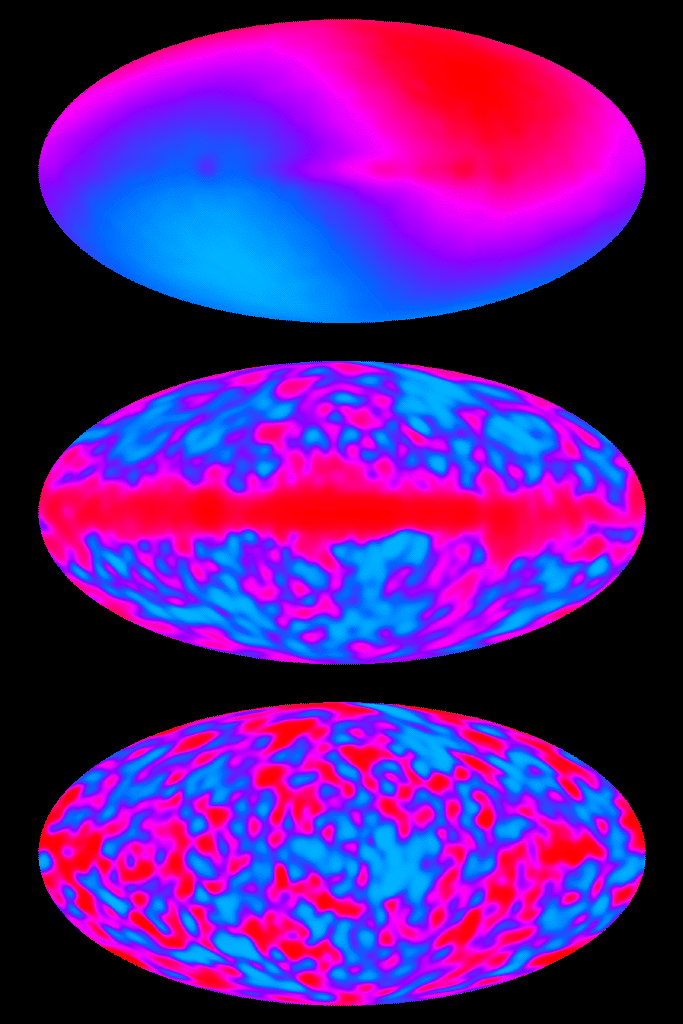 A. Penzias and R. Wilson were two Bell Laboratories engineers working on a microwave communication antenna in 1965. They discovered that no matter what they did they could not get rid of a certain level of background static that seemed to be coming from every direction. At first they thought it was pigeon dropping on the antenna.
A. Penzias and R. Wilson were two Bell Laboratories engineers working on a microwave communication antenna in 1965. They discovered that no matter what they did they could not get rid of a certain level of background static that seemed to be coming from every direction. At first they thought it was pigeon dropping on the antenna.
At the same time a group from Princeton University were actually searching for this background static which is the predicted relic of the Hot Big Bang.
|
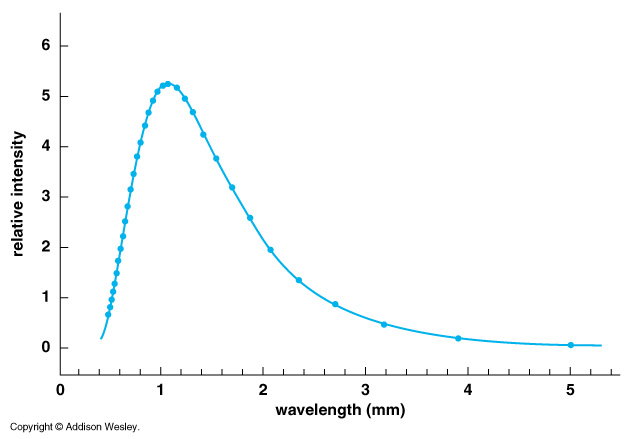
Since the Universe was once very hot and has been expanding it should now have a much lower temperature. Therefore it should emit radiation like a thermal emitter having that temperature (Wien's Law:  peakT = 2.898 x 10-3 m·K). peakT = 2.898 x 10-3 m·K).
The whole Universe radiates like a thermal emitter with a temperature of ~ 3K ( peak ~ 1 mm). It is the same in all directions! peak ~ 1 mm). It is the same in all directions!
An alternate view of this radiation is that it is the redshifted relic of the Universe at a very early time when it was so hot that matter and radiation were in thermal equilibrium with each other.
The CMB (Cosmic Microwave Background) shows that the early Universe was very homogeneous and isotropic.
|
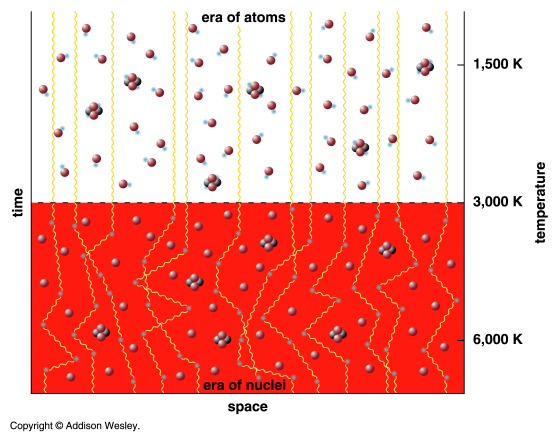 After the Big Bang, the Universe was extremely HOT and ionized. It was opaque to radiation dues mostly to free (unbound) electrons (they scatter photons quite strongly).
After the Big Bang, the Universe was extremely HOT and ionized. It was opaque to radiation dues mostly to free (unbound) electrons (they scatter photons quite strongly).
The Universe cooled as it expanded. Eventually (t ~ 1 million years), the temperature dropped to about 4000K. Now we had p+ + e-  H Atoms!. And the Universe becomes TRANSPARENT. Photons can freely stream. H Atoms!. And the Universe becomes TRANSPARENT. Photons can freely stream.
Those photons have now redshifted and are visible as a T = 3K blackbody.
They came from an opaque wall at z ~ 1300 (very far away).
This opaque wall marks the boundary (horizon) of our Observable Universe
! Even if the Universe is infinite we cannot see beyond this opaque wall.
NOTE: The Cosmic Microwave Background Radiation looks slightly higher in one direction and slightly cooler in the opposite direction. (roughly 1 part in 1000). This is due to the Solar System's motion about the Galaxy + the Galaxy's motion within the Local Group + the Local Group's motion with respect to the expanding Universe. Peculiar Motion of about 600 km/s in the direction of the Virgo Cluster.
|

Major Problem:
If the galaxies and clusters of galaxies formed by gravitational contraction of matter, where are the inhomogeneities ("clumps") from which they came? They should be visible as temperature inhomogeneities in the cosmic background radiation -- yet it is very smooth.
Breakthrough!: Clumps found with NASA's Cosmic Background Explorer (COBE) and BOOMERanG Experiment!. Tiny inhomogeneities in temperature (roughly 1 part in 105) --> clumps.
The smallest clumps (about 10° across, the resolution of COBE) are the "seeds" from which giant clusters of galaxies formed! The largest ones are the biggest structures ever seen in the Universe!
These small variations are the imprints of tiny ripples in the fabric of spacetime put there during the Big Bang. The Amplitude of the inhomogeneities suggests that there is much dark matter, and that  = 1 (i.e., Universe is flat). = 1 (i.e., Universe is flat).
But since all other studies of matter (including dark matter using gravitational lenses) only show  M = 0.3, We are left to wonder if the rest is made up from the energy density of the vacuum which would be the source of the Cosmological Constant ( M = 0.3, We are left to wonder if the rest is made up from the energy density of the vacuum which would be the source of the Cosmological Constant (  = 0.7). = 0.7).
|
Big Bang Nucleosynthesis
 Take the Universe back in time to when it was incredibly young, small, dense, and hot...
Take the Universe back in time to when it was incredibly young, small, dense, and hot...
|
From the abundance of light elements now we can deduce the conditions of the early Universe (including its density and spacetime curvature).
Problem: 2He4 formed by stars also. Contaminates the primordial mix. Use deuterium instead. It is very sensitive to the density at early times.
If density is high for a long time the deuterium gets used up fast in the reaction
1H2 + n  2He3 + e- + antineutrino. High for a long time happens in an overdense Universe:
2He3 + e- + antineutrino. High for a long time happens in an overdense Universe:  M > 1. Leads to a low abundance of 1H2
M > 1. Leads to a low abundance of 1H2
We measure a high abundance of 1H2 in primordial gas clouds that lie between the galaxies. That means that  M < 1. Current measurements of deuterium and other light elements suggest that density in Baryons (neutrons, protons) is about
M < 1. Current measurements of deuterium and other light elements suggest that density in Baryons (neutrons, protons) is about  B
B  0.03.
0.03.
Other measures of  M which includes dark matter (gravitational lensing in clusters, etc.) suggest that
M which includes dark matter (gravitational lensing in clusters, etc.) suggest that  M
M  0.3. Which again tells us that the dark matter makes up 90% of the mass of the Universe.
0.3. Which again tells us that the dark matter makes up 90% of the mass of the Universe.
Big Bang Problems
There are a couple of problems that arise with the Standard Hot Big Bang Model.
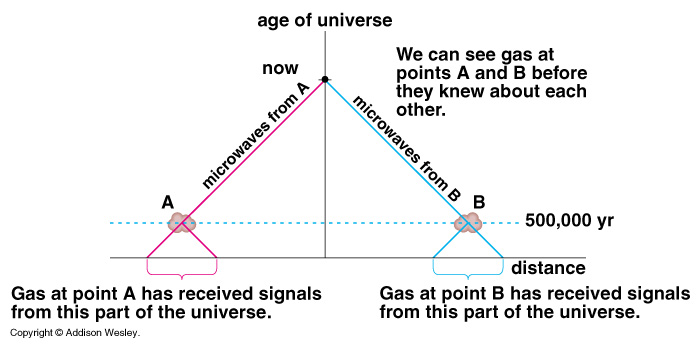
- Why is the Universe (and in particular the CMB) so homogeneous and isotropic? If we calculate the angular size of the Particle Horizon on the sky at the time of the origin of the CMB (z ~ 1300) we find that regions of the CMB that are separated by more than 1° did not know about each other. So why do they have the same temperature and density?
- Why is the Universe so closed to being flat? If we run the expansion backward in time we find that it gets closer and closer to being flat. It's density would have needed to have been well tuned to produce a Universe so nearly flat some 10 billion years later.
|
A possible Solution came from an Astronomer in 1980 by the name of Alan Guth.
Inflation
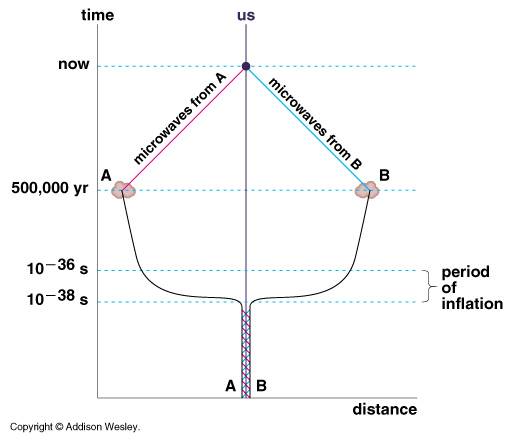 Suppose the Universe extremely rapidly for a while. The entire Observable Universe could have come from a tiny volume of uniform temperature and density. An expansion in size by a factor of 10100, A Googol! (10-30 cm - 1070 cm).
Suppose the Universe extremely rapidly for a while. The entire Observable Universe could have come from a tiny volume of uniform temperature and density. An expansion in size by a factor of 10100, A Googol! (10-30 cm - 1070 cm).
This is called Inflation.
Inflationary expansion would have taken place between t = 10-38 s and t = 10-36 s.
|
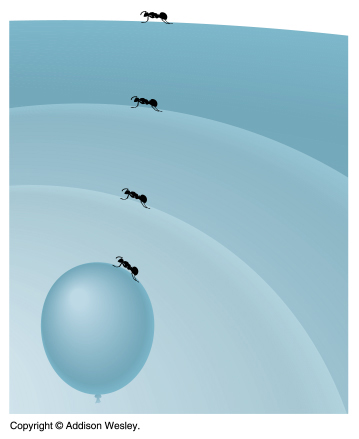
The tiny volume was homogeneous and isotropic and so the observed Universe today also is.
All curvature flattened out because of the expansion. Locally the Universe is so flat because because the Radius of Curvature is so large. So   1 now, no matter what the initial conditions. 1 now, no matter what the initial conditions.
|
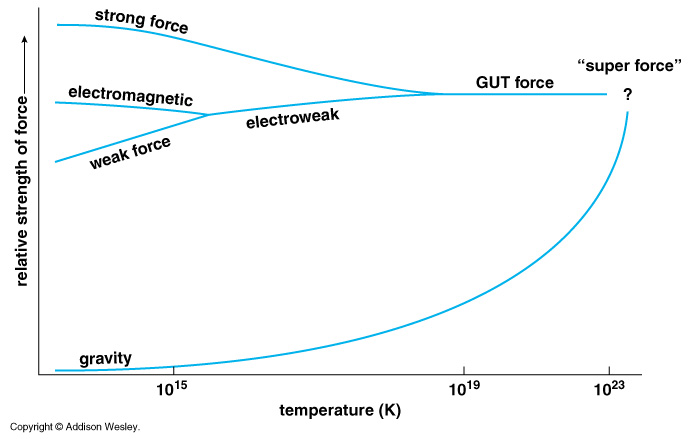
Why did the inflation occur? : Look at Grand Unified Theories (GUTs).
These are theories that attempt to unify the 4 fundamental forces of nature. Originally magnetic and electric forces were considered separately, but it was recognized that they were both aspects of the same interaction between charges. ---> Electromagnetic force. It has been discovered that the same is true of the weak nuclear force and the electromagnetic force. They have been combined in a single elctroweak force. A Grand Unified Theory would be one in which we could unify the electroweak with the strong nuclear force. A Theory of Everything (TOE) would also unify these forces with gravity.
Right after the Big Bang, the temperatures and densities are exceedingly high. Photons are in equilibrium with particle-antiparticle pairs. All the forces are unified (except perhaps gravity ???). They all behave the same and are indistinguishable from one another. Symmetric: unified.
As the Universe cooled below 1028 K (t = 10-35 s) the strong forces "freezes out", it becomes a different manifestation of the same unified force. Symmetry is broken because of a lower total Energy.
(Example the phase transition of water from liquid to solid when it drops below 0° C)
Suppose the Universe cooled below 1028 K and yet the strong force does not freeze out. The symmetry is not broken: SUPERCOOLED!
The Universe contains too much energy for its physical state (like liquid water below 0° C).
Creates an "Energy of a False Vacuum", which causes the Universe to expand impossibly fast --> Inflation.
Eventually the phase transition occurred (e.g. water --> ice) and energy is released which re-heats the Universe.
All of the matter in the Universe formed from the energy released by the symmetry breaking of the string nuclear force. After particles form there is no more inflation and a normal Hubble expansion continues.
|
Key Point: Observed Universe was only a tiny (smaller than a proton) homogeneous, isotropic volume before inflation. Expanded by a HUGE factor, Therefore the Universe now looks homogeneous, isotropic, and essentially flat.
Epicycles within epicycles anyone???
Origin of the Universe
From scientific tooth fairies to the completely absurd...
From where did the Universe come before inflation? (t < 10-35)
NOTE: it doesn't make any sense to ask what was going on before the Universe began. There was no time before time had begun. The question becomes meaningless.
Hold on for some rampant speculation..........
The Universe may have simply been a random fluctuation out of nothing!
Heisenberg's Uncertainty principle states that we cannot measure quantities simultaneously with arbitrary precision. For example if we no exactly where a particle is we have no idea what its momentum is. If we no exactly what the energy of a particle is we have no idea when it has that energy.
Positive energy can be created out of nothing for very short times. Something that has precisely zero total energy can live infinitely long. If the entire Universe (matter + radiation + gravity + cosmological constant) has an energy adding up to zero (the critical Universe). Then it can exist forever even though it came from NOTHING!
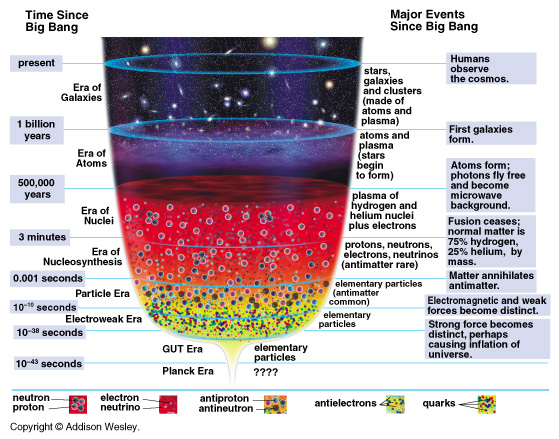
Return to Class Notes Page
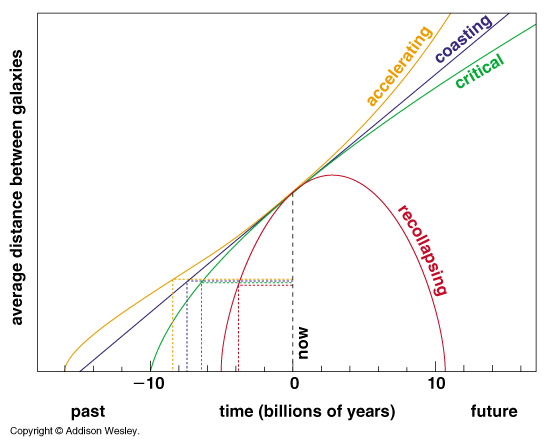 How do we measure the curvature of the Universe?
How do we measure the curvature of the Universe?
 =
=  /
/ crit
crit
 > 1
> 1  Closed
Closed  = 1
= 1  Flat
Flat  < 1
< 1  Open
Open  Flat
Flat Positive Curvature (Closed)
Positive Curvature (Closed) Negative Curvature (Open)
Negative Curvature (Open) R3 if flat. Example: doubling the distance should yield 8 times the number of galaxies.
R3 if flat. Example: doubling the distance should yield 8 times the number of galaxies.  Positive Curvature (Closed)
Positive Curvature (Closed) Negative Curvature (Open)
Negative Curvature (Open) A. Penzias and R. Wilson were two Bell Laboratories engineers working on a microwave communication antenna in 1965. They discovered that no matter what they did they could not get rid of a certain level of background static that seemed to be coming from every direction. At first they thought it was pigeon dropping on the antenna.
A. Penzias and R. Wilson were two Bell Laboratories engineers working on a microwave communication antenna in 1965. They discovered that no matter what they did they could not get rid of a certain level of background static that seemed to be coming from every direction. At first they thought it was pigeon dropping on the antenna.

 After the Big Bang, the Universe was extremely HOT and ionized. It was opaque to radiation dues mostly to free (unbound) electrons (they scatter photons quite strongly).
After the Big Bang, the Universe was extremely HOT and ionized. It was opaque to radiation dues mostly to free (unbound) electrons (they scatter photons quite strongly).

 Take the Universe back in time to when it was incredibly young, small, dense, and hot...
Take the Universe back in time to when it was incredibly young, small, dense, and hot...

 Suppose the Universe extremely rapidly for a while. The entire Observable Universe could have come from a tiny volume of uniform temperature and density. An expansion in size by a factor of 10100, A Googol! (10-30 cm - 1070 cm).
Suppose the Universe extremely rapidly for a while. The entire Observable Universe could have come from a tiny volume of uniform temperature and density. An expansion in size by a factor of 10100, A Googol! (10-30 cm - 1070 cm).


